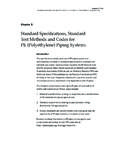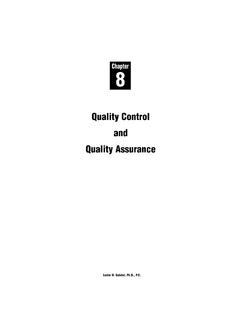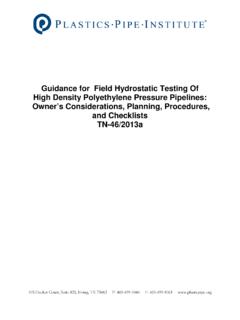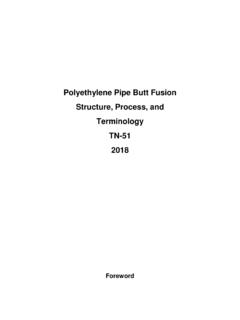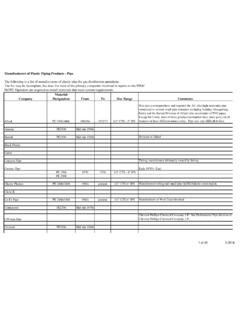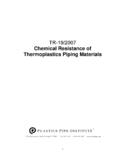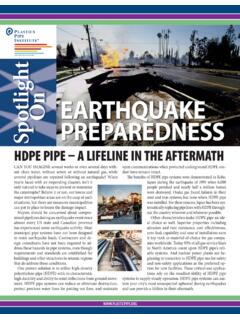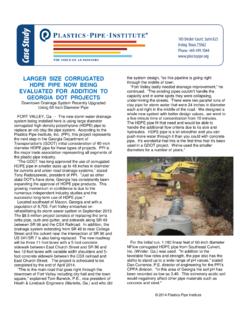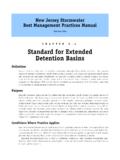Transcription of Chapter 3: Use of Corrugated HDPE Products
1 3 ChapterUse of Corrugated HDPE ProductsOrin BennettCHAPTER 3: USE OF HDPE PRODUCTSC orrugated HDPE Pipe CharacteristicsHigh-density polyethylene (HDPE) is a versatile material and has some ideal characteristics for use in underground structures. HDPE pipe is relatively lightweightallowing for easier and less costly transportation and installation costs. It is not brittleand therefore not susceptible to cracking during pipe handling and installation activities. Once formed into a pipe, HDPE has a smooth surface, which is resistant to abrasion, corrosion and chemical scouring. The smooth surface provides excellentpipeline flow characteristics. HDPE pipe is structurally strong and has the ability tosupport large loads. HDPE has the ability to relax under stress.
2 This characteristic provides advantages for underground structures and also helps define limitations of use. As HDPE pipe isloaded, the pipe relaxes immediately, and over time, allows the load to be transferredto the adjacent soil. This characteristic allows the pipe to off-load points of local relaxation may result in slight pipe reformation over time to accommodate in-place loading conditions. Such re-formations are believed to cause long-term structuralstability. Corrugated HDPE is an excellent choice for gravity flow or low-head pipeline situations. The structural stability of Corrugated HDPE pipe is produced by threepipe designs. According to AASHTO M294, they are defined as: Type C This pipe shall have a full circular cross section, with an annular Corrugated surface both inside and outside.
3 Type S This pipe is a full circular dual-wall cross section, with an outer Corrugated pipe wall and a smooth inner liner. Type D This pipe is a circular cross section consisting of an essentially smooth inner wall joined to an essentially smooth outer wall with annular or spiral connecting OF Corrugated HDPE PRODUCTSCHAPTER 3: USE OF HDPE PRODUCTST ypically, Type C pipe with interior and exterior Corrugated walls is available in 3-inch through 24-inch diameters. Interior and exterior Corrugated pipe in smallerdiameters are connected with separate snap-on connections with no gasket. In largerdiameters, the connections are made with Corrugated bands secured with plastic specific design of the pipe as shown in Figure 3-1 varies by manufacturer.
4 Eachsection is associated with specific structural properties and performance characteristics are available from the manufacturer for use in load calculations. Figure 3-1: Type C HDPE Pipe with Interior and Exterior CorrugationsFigure 3-1 Chapter 3: USE OF HDPE PRODUCTSPipe manufacturers provide various pipe joining methods depending on the pipestyle and project requirements. Coupling bands, with or without a gasket, wraparound the pipe and are secured with plastic ties. Gasketed bell and spigot joints are also widely used. Nonrated and nonpressure tested watertight joints are suitablefor the majority of nonpressure (gravity flow) drainage applications and typically do not experience significant leakage. For environmental and other reasons, most manufacturers also have a pressure-rated watertight joint suited for nonpressureapplications.
5 Joints are rated at either psi or psi when tested in accordancewith ASTM D 3212. Figure 3-2: Type S HDPE Pipe with Corrugated Exterior and Smooth InteriorFigure 3-2 Chapter 3: USE OF HDPE Products Figure 3-3: Use of a Gasketed Coupling for HDPE Sewer Pipeline ApplicationFigure 3-3 Although HDPE pipe Products are versatile, the primary use of Corrugated HDPE is for gravity flow water management. Examples of these water management systemsinclude: storm drainage subsurface drainage sanitary sewers leachate collection detention/retention stormwater management systemsStorm DrainageCorrugated HDPE has become the pipe of choice for many of these drainageapplications.
6 Stormwater systems require a wide range of pipe sizes and coverrequirements in both landscaped and parking areas. Corrugated HPDE is adurable and cost-effective pipe material for these on-site drainage pipe materials approved for drainage conveyance in public rights-of-way are determined by the jurisdiction responsible for maintenance of such facilities. HPDE has been used for highway and roadway drainage culverts and storm drainage Chapter 3: USE OF HDPE Products systems for more than 20 years. Most state Departments of Transportation, cities and counties have included HDPE in their Departments Standard ConstructionSpecifications. Installations have included culverts under very high fills and underminimal cover. Many installations have been monitored and have demonstrated satisfactory to exceptional performance.
7 Concerns of insufficient strength, crackingand deterioration over time have proven to be unwarranted. Subsurface DrainageCorrugated HDPE pipe can also be produced with perforations. The perforations allow subsurface water to be collected and transplanted to favorable locations for discharge. Subdrainage systems are used to collect leachate under landfill systems also are used to control and direct underground water transportand to encourage proper surface water percolation in golf courses, athletic fields, hillside development projects and in agricultural fields. Often, subdrainage systemsare used to lower the groundwater table. For athletic field development, subdrainagesystems have been connected to air vacuum systems to encourage the downwardmovement of surface and subsurface water.
8 Figure 3-4: Highway Drainage Culvert with HDPE Flared End SectionFigure 3-4 Chapter 3: USE OF HDPE Products Perforated Corrugated HDPE pipe is often used to control water levels in agriculturalland. Perforated pipe is installed to collect and transport subsurface drainage and/orgroundwater or to control the depth to SewersHDPE pipe is an ideal septic system leach pipeline material. One type of HDPE pipe has been specifically designed with special perforations to allow percolation. Leachate CollectionThe mining industry has a special application of subdrainage that is ideal for Corrugated HDPE perforated pipe. A technique called heap leachingis used to recover low-grade deposits of copper, gold and silver.
9 A cyanide solution sprayed oversoil containing gold or silver converts the minerals to a chemical compound. Thesolution is collected in a perforated pipe subdrainage system and transported to ponds. The gold or silver is recovered from the ponds using carbon absorption or precipitation. HDPE is well-suited to this process because it is highly resistant tochemical attack. Tests have shown little or no degradation of HDPE with long-termexposure to a pH range from to Storm Water Management SystemsCurrent regulations in most areas limit the rate of storm water runoff as well as the level of pollutants allowed in discharged storm water. Urbanization of land can dramatically alter the natural movement of water. When runoff is transported awayfrom critical areas, it can cause problems where recharge of aquifiers is necessaryto maintain a steady groundwater supply.
10 To counter these problems, storm water retention systems hold runoff until the surrounding soil can accept it via percolation,allowing aquifiers to be recharged. In other cases, the existing storm drainage trunksystem is not designed to accept increased peak flow and the runoff must be retaineduntil the peak flow has jurisdictions require developers of projects to assure that downstream peakstorm discharge flows remain the same afterdevelopment. Storm water retention and detention systems can be either above-ground ponds orsubsurface piping. Ponds are the least prone to early siltation and clogging, but couldpresent child safety and long-term aesthetic problems such as insect breeding, weedgrowth, odor and refuse control. Subsurface retention/detention systems use availableland efficiently at a low maintenance cost, while posing little or no public safety oraesthetic problems.
